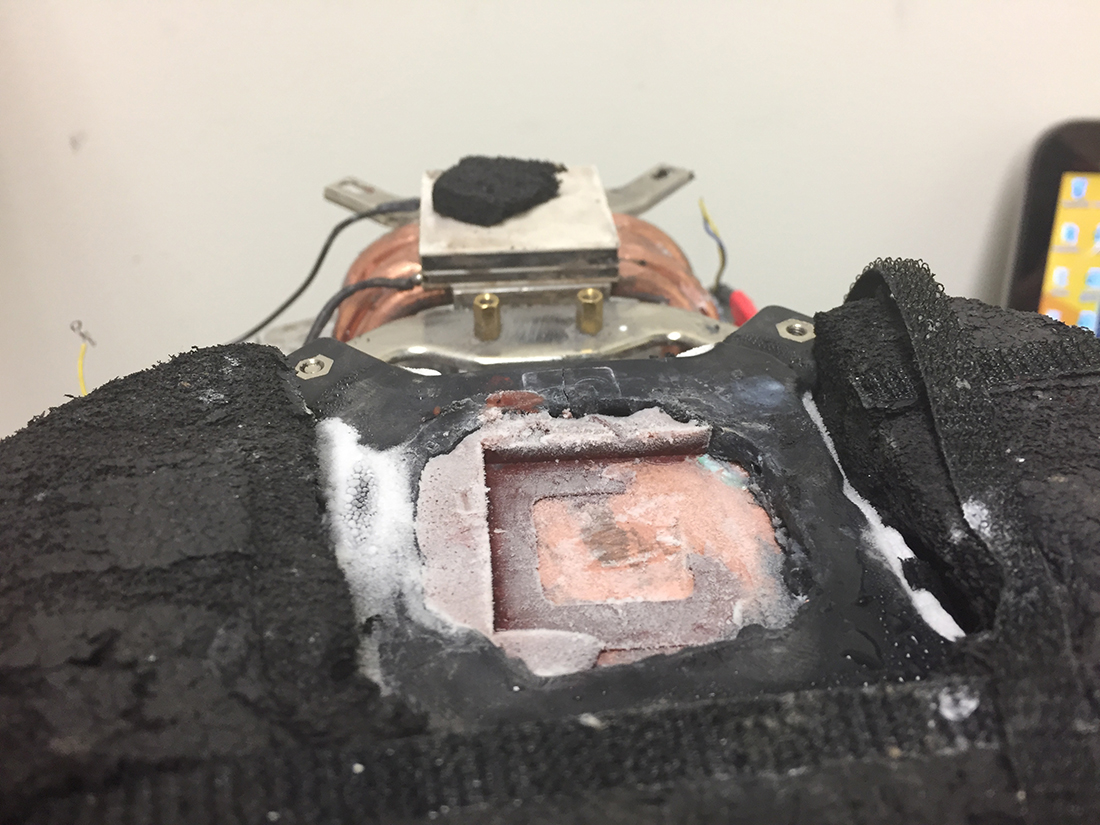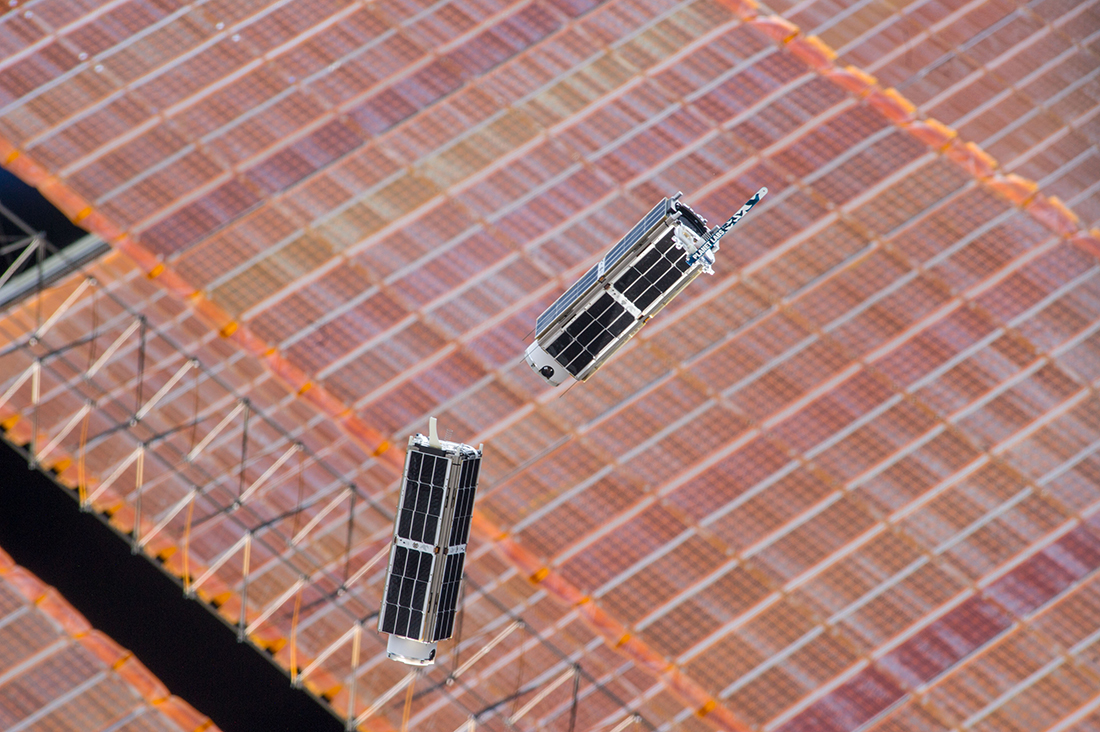Northwestern University’s SpaceICE team, led by Northwestern Professor David Dunand, is preparing to test freeze-casting of materials in space, in collaboration with the University of Illinois at Urbana-Champaign and Bradley University. Fabricating materials is essential for a journey to Mars or for future space colonies. The SpaceICE team is pioneering the freeze-casting instrumentation for the small CubeSat, a cubic satellite that UIUC is building for the 2018 NASA-funded mission. Medill reporter Lakshmi Chandrasekaran is embedding with the researchers as the mission efforts rev up this summer.
By Lakshmi Chandrasekaran
I was meeting with Krysti Scotti, who kick- started the Northwestern University’s SpaceICE project in the Dunand Lab while she was still an undergraduate. She just finished her bachelor’s degree this spring and is starting work on her Ph.D. as SpaceICE readies for a space launch.
While waiting for Krysti to arrive at the lab, I met with another of Dunand’s first-year Ph.D. students, Stephen Wilke, as he completed freeze-casting experiments with iron oxide nanopowder. We chatted for a bit and I learned that his wife (a fifth year Ph.D. student in environmental sciences at NU) is pursuing a career in science writing in California through a mass communication fellowship from the American Association for the Advancement of Science. It is a small world and I often seem to be running into Ph.D.s, pursuing science communication as a career! That’s what I am doing in graduate school at Medill after working as a science reporter with a Ph.D. in mathematics. The graduate program gives us a chance to embed with science research teams to produce in-depth stories and I am embedding with SpaceICE.
Krysti arrived a bit late for our 11 a.m. meeting and dashed into the lab! “I overslept,” she says. Considering, that she was up until 6 a.m. working on the research, I am not too surprised.
We start chatting about the freeze-casting technique, a pioneering way to fabricate materials that will be needed to build structures in space. I asked Krysti about her trip in NASA’s C-9 parabolic flights and how they performed freeze-casting in them as a way to prepare for the NASA space mission to try out freeze-casting in orbit. Krysti mentions that the C-9 flights achieved a 30-second microgravity environment per parabola and typically each flight comprised of 50 such parabolas.
“You can get a lot of samples {with the C-9) but you have to freeze very fast,” says Krysti. This is done to mimic the CubeSat mission, which will orbit Earth every 90 minutes for six months in a microgravity environment of weightlessness. University of Illinois, Urbana-Champaign (UIUC) researchers specialize in the CubeSat part of the project – making small cubic satellites for experiments. Krysti mentions that next week a couple of UIUC students will visit the Dunand Lab for a few days and I’ll get an opportunity to meet them.

Eager to see the satellite “payload” – the freeze-casting experiment – I ask Krysti if the team has it completed. Since this is a NASA-funded project, Krysti tells me that the students have several milestone reviews before they start building the actual mission apparatus. “The review is super stressful and you will be here so you will be able to experience it!” says Krysti.
But what do they do in the meantime? They build computer-aided design (CAD) models to consider every variable for freeze-casting in space. And modeling occupied Krysti’s time until 6 a.m. that morning! “We have been working on probably the millionth model drawing since the designing of the payload present itself with a unique set of challenges,” says Krysti.
Now, what are some of the critical issues with the design model? “The sample container is the most challenging part of the project,” Krysti says and starts to walk me through some of the day-to-day challenges in the lab where the lab team is testing how freeze-casting works on Earth.
You start with a suspension, mixing a powder of something like titanium oxide evenly in water. Now you want to fabricate a new material out of this suspension by making the titanium oxide particles accumulate and clump together to form walls in the ice. As a next step, you solidify the suspension by putting it on a frozen plate to freeze the water into ice. The ice crystals nucleate at the bottom and begin to grow to the top pushing other particles out of its way. These particles accumulate ahead of the crystals, corrugating into a microscopically porous solid.
With continued ice growth, more and more particles clump together until they form wafers of materials between the ice dendrites. This suspension is then placed in the freeze dryer for ice sublimation, a process that transforms ice directly into vapor. This removes the ice while keeping the titanium oxide wafers together. The material is very fragile as this point and it’s sintered (baked) so that the titanium oxide particles are bonded by heat to create the new material.
I learn that one of the most difficult things to implement is that the suspension within the container cannot be exposed to a vacuum. In a vacuum – and space is considered a vacuum – the water will evaporate away leaving titanium oxide as the original powder and not as a new material. The easy solution then would be to put it in a closed airtight container of glass, right? Not really, Krysti says. Since the freeze-casting process involves freezing and thawing, back and forth, not something glass cannot accommodate. Also, CubeSats get launched from a rocket, with a g-force during launch of 8 to12 times the gravity we feel on Earth and nothing should shatter during launch. “Glass is more likely to shatter,” says Krysti.
To overcome this problem, they use a Pyrex container instead. An important property of Pyrex is that it expands at the same rate when heated, as Kovar, which forms the base of the container. For someone like me who has not had any physics and chemistry since high school, all these technical details are a lot to take in! So I ask Krysti to back up a bit. What’s Kovar? “Basically it is an alloy made of aluminum and nickel,” she adds.
Krysti mentions that it is really important for the container material and its base covered with the alloy, to have similar thermal expansion coefficient when heated. This is because the suspension inside the container would undergo thermal cycling and they wouldn’t want the container materials expanding and contracting at different rates during the freeze-casting process. I am amazed to find so much thought going into designing a simple container that will hold the suspensions!
Listening to the umpteen numbers of challenges and strategies that go into making the models, I wonder how long it took for the students to design the experiment. Krysti reads my mind. “It took us almost a year. We started last summer.”
It’s about 1 p.m. now and Krysti says that she feels as though she’s inundated me with a lot of technical information. Indeed! We decide to break for lunch. For the morning meeting with Krysti, I braced myself to learn about the SpaceICE project – mostly because I have never covered anything related to space before and I am a complete novice when it comes to material sciences.
After the lunch break, with my curiosity sufficiently piqued, I go back to the lab again and this time I find Krysti in a deep conversation with other SpaceICE team members – Andy McIntosh, the team’s design engineer and Luke Duros, an undergraduate student who is working as a summer intern in the SpaceICE project. Andy leaves today for a job interview and will be out for a week. But next week, I can shadow him in his workshop and observe him working on the sample container parts, up close in action!
I briefly chat with Andy and he shows me a sample of the container that he has designed. It looks really tiny at about 2 inches high! This small container has to hold a number of things – the suspension, an O-ring seal, a spring above the seal that helps the container expand and contract when freezing and thawing takes place.
Besides, “we need to insert thermocouples into the container which would be welded to the O-ring seal and take temperature readings,” mentions Krysti. What is a thermocouple, I ask Krysti and she shows me a prototype. It is basically a thermometer to measure temperatures. Since we are looking at micro-scale components here, the thermocouples that Krysti shows me almost look like very thin wires.
Krysti also informs me about another issue which they face – outgassing! That means materials simply vaporize. “For parabolic flights on an airplane, we don’t have to worry about materials degrading or stuff like that. For CubeSat most plastics outgas and they degrade due to vacuum. The [camera] lens is plastic, so that could outgas and over time, it would lose mass. No lens equals no pictures,” she laughs.
And Krysti proceeds to list the set of materials for the payload construction chosen to reduce the problem of outgassing – plates made of aluminum, wiring made of Teflon and special order lenses to avoid plastic. Most importantly, they buy materials that are vacuum-tested. Since it’s not possible to buy off the shelf components such as these, all these constraints make the experiments expensive too.
Time flies as I chat with Krysti about all these different design challenges and it’s late afternoon – almost time for me to leave. Krysti offers to show me Stephen’s frozen suspension before I leave. Then Stephen walks into the lab and says he is having a bad day since his suspension collapsed!

They take me to the room inside the lab where freeze-casting takes place and show me an apparatus (they call it the freeze-caster), where the “suspension” was supposed to form a solid when frozen but hasn’t! “My slurry leaked out rather than staying in the mold, since my mold containing the suspension was not sealed against the copper plate, which sits on the freeze-caster,” says Stephen.

Although it is probably just another day spent working in the lab for the SpaceICE team, I feel I have discovered a whole new world. I mention to Krysti at this point, that I would love to see a freeze- casting experiment from scratch! Krysti promises that I will definitely have an opportunity to do so during my time embedding in the lab this summer. I am very much looking forward to that day!


